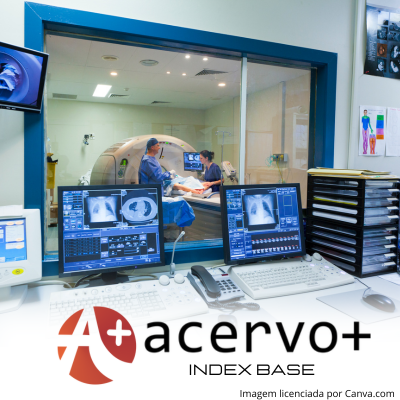Inteligência artificial aplicada ao diagnóstico de câncer por exames de imagem
##plugins.themes.bootstrap3.article.main##
Resumo
Objetivo: Revisar a aplicação da Inteligência Artificial (IA) no diagnóstico de câncer através de exames de imagem, analisando tendências e avanços recentes na intersecção entre IA e medicina diagnóstica. Métodos: Foi realizada uma pesquisa bibliográfica em bases de dados eletrônicas, selecionando artigos científicos, revisões sistemáticas e meta-análises publicados entre 2017 e 2023. Os estudos incluíram algoritmos de IA, técnicas de aprendizado de máquina e redes neurais aplicadas a exames de imagem para detecção, classificação e diagnóstico de câncer. Resultados: A análise focou em modelos de reconhecimento de imagem para diagnóstico de câncer, priorizando métricas de sensibilidade e especificidade. Foram destacados estudos que compararam o desempenho de radiologistas com sistemas de IA mostrando que em alguns casos a IA superou os profissionais e, em outros, melhorou significativamente o desempenho dos radiologistas quando usada como assistência. Considerações finais: A IA mostrou-se uma ferramenta promissora no diagnóstico de câncer por imagem. A combinação de IA com dados clínicos pode melhorar as métricas de diagnóstico. Limitações incluem a qualidade e quantidade de imagens para treinamento, mas novas tecnologias como IA Generativa estão surgindo para superar esses desafios.
##plugins.themes.bootstrap3.article.details##
Copyright © | Todos os direitos reservados.
A revista detém os direitos autorais exclusivos de publicação deste artigo nos termos da lei 9610/98.
Reprodução parcial
É livre o uso de partes do texto, figuras e questionário do artigo, sendo obrigatória a citação dos autores e revista.
Reprodução total
É expressamente proibida, devendo ser autorizada pela revista.
Referências
2. BENYES YK, et al. A Comparative Analysis of Deep Learning Models for Automated Cross-Preparation Diagnosis of Multi-Cell Liquid Pap Smear Images. Diagnostics, 2022; 12: 1838.
3. BOYD BJ, et al. Successful oral delivery of poorly water-soluble drugs both depends on the intraluminal behavior of drugs and of appropriate advanced drug delivery systems. European Journal of Pharmaceutical Sciences, 2019; 137: 104977.
4. CASCELLA M, et al. Utilizing an artificial intelligence framework (conditional generative adversarial network) to enhance telemedicine strategies for cancer pain management. J Anesth Analg Crit Care, 2023; 3(1): 19.
5. HOLMSTRÖM O, et al. Point-of-Care Digital Cytology with Artificial Intelligence for Cervical Cancer Screening in a Resource-Limited Setting. JAMA Network Open, 2021; 4(3): 211740.
6. HUANG HW, et al. Development of a light-weight deep learning model for cloud applications and remote diagnosis of skin cancers. The Journal of Dermatology, 2021; 48: 310-316.
7. HUSSAIN S, et al. Modern Diagnostic Imaging Technique Applications and Risk Factors in the Medical Field: A Review. Biomed Res Int, 2022; 5164970.
8. JUNIOR GBV, et al. Métricas utilizadas para avaliar a eficiência de classificadores em algoritmos inteligentes. Centro de Pesquisas Avançadas em Qualidade de Vida, 2022; 14: 2(1).
9. KAPLAN A e HAENLEIN M. Siri, in my hand: Who’s the fairest in the land? On the interpretations, illustrations, and implications of artificial intelligence. Business Horizons, 2019; 62(1): 15-25.
10. KHOSRAVI P, et al. A Deep Learning Approach to Diagnostic Classification of Prostate Cancer Using Pathology–Radiology Fusion. Journal of Magnetic Resonance Imaging, 2021; 4: 462–471.
11. KIM HE, et al. Changes in cancer detection and false-positive recall in mammography using artificial intelligence: a retrospective, multireader study. Lancet Digit Heal, 2020; 2(3): 138–48.
12. KOOI T, et al. Large scale deep learningfor computer aided detection of mammographic lesions. Med Image Anal, 2017; 35: 303–312.
13. KUO KM, et al. The accuracy of artificial intelligence used for non-melanoma skin cancer diagnoses: a meta-analysis. BMC Medical Informatics and Decision Making, 2023; 23: 138.
14. LIN H, et al. Dual-path network with synergistic grouping loss and evidence driven risk stratification for whole slide cervical image analysis. Medical Image Analysis, 2021; 69: 101955.
15. LIU F, et al. Research progress of medical image recognition based on deep learning. Chin J Biomed Eng, 2018; 37(1): 86–94.
16. LIU J, et al. Application and research of deep learning in medical image recognition. J Qingdao Univers (Nat Sci Edit), 2018; 31(1): 69-7480.
17. LIU R, et al. A review of medical artificial intelligence. Global Health Journal, 2020; 4(2).
18. LOTTER W, et al. Robust breast cancer detection in mammography and digital breast tomosynthesis using an annotation-efficient deep learning approach. Nat Med, 2021; 27(2): 244–9.
19. MASOOD A, et al. Computer-Assisted Decision Support System in Pulmonary Cancer detection and stage classification on CT images. Journal of Biomedics Informatics, 2018; 79: 117-128.
20. MATSUOKA Y, et al. Deep-learning prostate cancer detection and segmentation on biparametric versus multiparametric magnetic resonance imaging: Added value of dynamic contrast-enhanced imaging. International Journal of Urology, 2023; 1103-1111.
21. MCKINNEY SM, et al. International evaluation of an AI system for breast cancer screening. Nature, 2020; 577(7788): 89-94.
22. MISHKIN D, et al. Systematic evaluation of convolution neural networks advances on the Imagenet. Computer Vision and Image Understanding, 2017; 161: 11-19.
23. NASSER M e YUSOF UK. Deep Learning Based Methods for Breast Cancer Diagnosis: A Systematic Review and Future Direction. Diagnostics, 2023; 13: 161.
24. PUPPE F. Introduction to knowledge systems. Artificial Intelligence in Medicine, 1997; 9(2): 201-203.
25. RIVEIRA-MARTIN M, et al. Multi-vendor robustness analysis of a commercial artificial intelligence system for breast cancer detection. Journal of Medical Imaging, 2023; 10(5): 051807.
26. SALIM M, et al. External Evaluation of 3 Commercial Artificial Intelligence Algorithms for Independent Assessment of Screening Mammograms. JAMA Oncol, 2020; 6(10): 1581–8.
27. SANTOS MO, et al. Estimativa de Incidência de Câncer no Brasil, 2023-2025. Revista Brasileira de Cancerologia, 2023; 69(1): 213700.
28. SORNAPUDI S, et al. Comparing Deep Learning Models for Multi-cell Classification in Liquid- based Cervical Cytology Image. AMIA Annu Symp Proc, 2019; 820–827.
29. VASWANI A, et al. Attention Is All You Need. Conference on Neural Information Processing Systems. NIPS, 2017.
30. ZHANG X, et al. Deep learning PET/CT-based radiomics integrates clinical data: A feasibility study to distinguish between tuberculosis nodules and lung cancer. Thoracic Cancer, 2023; 1802-1811.

